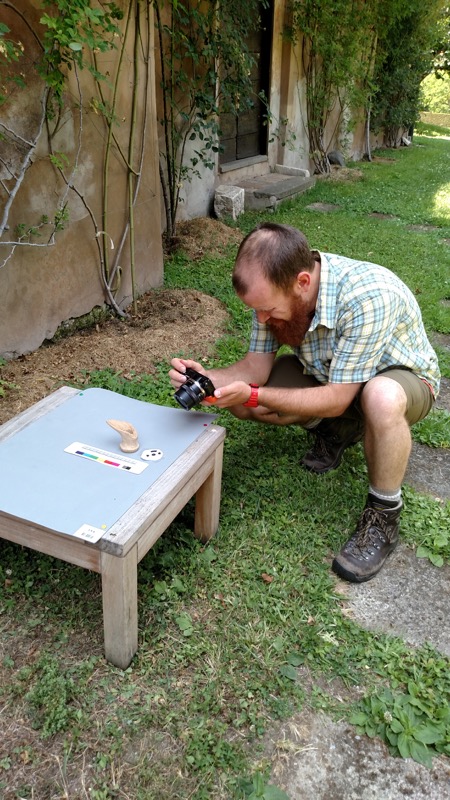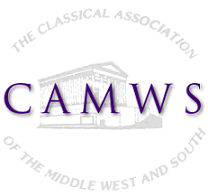2017 Benario Award Winner Andrew Carroll
 While I have visited the eternal city many times as a tourist, an archaeologist, and even tour guide this was my first time being in Rome as a student. I have been teaching Latin and archaeology for many years now and have greatly missed the chance engage my learner-self. This summer I took my laptop and mouse instead of my trowel and plumb bob and attended a course in best practices in Digital Archaeology and 3D modeling at the American Academy of Rome. For over a decade I've been on the trowel's edge when working with artifacts, but I had decided to take a break from playing in dirt and wanted to expand my skill set for handling artifacts after sending them to the laboratory. It just so happened that this was the first summer that the American Academy was offering this series of short one week courses in digital skills. I was thrilled to be a part of the pioneer class. On the first day, Dr. Laura Banducci and Dr. Rachel Opitz, our instructors, retrieved us from the gate and showed us to our classroom in the Casa Rustica. We jumped right into our lessons and selected a brick stamp to learn how to model digitally.
While I have visited the eternal city many times as a tourist, an archaeologist, and even tour guide this was my first time being in Rome as a student. I have been teaching Latin and archaeology for many years now and have greatly missed the chance engage my learner-self. This summer I took my laptop and mouse instead of my trowel and plumb bob and attended a course in best practices in Digital Archaeology and 3D modeling at the American Academy of Rome. For over a decade I've been on the trowel's edge when working with artifacts, but I had decided to take a break from playing in dirt and wanted to expand my skill set for handling artifacts after sending them to the laboratory. It just so happened that this was the first summer that the American Academy was offering this series of short one week courses in digital skills. I was thrilled to be a part of the pioneer class. On the first day, Dr. Laura Banducci and Dr. Rachel Opitz, our instructors, retrieved us from the gate and showed us to our classroom in the Casa Rustica. We jumped right into our lessons and selected a brick stamp to learn how to model digitally.
For the rest of the week, everyday we would take different artifacts and create 3D models. We spent a lot of time getting the lights right and positioning our objects. The right preparation was important in order to get high quality images because we learned that taking our time at this point would make our lives easier later. Once we had taken our photos, the subsequent steps were automated in the Agisoft program. These steps took time, so in between them we had lively discussion in our diverse student group about the theories behind digital archaeology. We covered topics from ethics of data preservation to the DIY attitude of archaeologists as well as looking at different ways small finds can be used in archaeological reporting.
Living at the academy also allowed me to explore an area of the city that I had not really seen before. It allowed me to learn more about the growth of the modern state of Italy, something I know precious little about. I visited the Museo della Republica Romana e della Memoria Garibaldina, and took leisurely strolls reading the wayside panels that peppered these streets far from the ancient centers I knew so well. It never ceases to amaze me how much history is packed into Rome. Before I knew it, the week was over and I had to pack my bags to travel back home, but leaving the city would not be the end of my interaction with digital archaeology.
The course length was helpful, since it fit perfectly into the summer conference schedule for teachers. I returned excited to share what I had learned and started many conversations at the ACL's Summer Institute about digital technology in the Latin/Classics classroom. Upon returning to Denver I began working with the Denver Museum of Nature and Science and we have started a program to make 3D modeling of their artifacts. Using these artifacts I am teaching my high school students how to model objects and manage a digital database. I plan to share initial thoughts on this type of collaboration in January at the Annual Meeting of the AIA/SCS in Boston. I hope you will stop by the poster session to see how things have progressed.
 I am so thankful for the Benario Award as it allowed me to visit the American Academy and participate in this class. I hope that the American Academy continues to offer classes like this to the wider population of classical scholars, and I hope that CAMWS continues to fund the non-traditional scholars who want to participate in these types of classes.
I am so thankful for the Benario Award as it allowed me to visit the American Academy and participate in this class. I hope that the American Academy continues to offer classes like this to the wider population of classical scholars, and I hope that CAMWS continues to fund the non-traditional scholars who want to participate in these types of classes.
Andrew Carroll
Regis Jesuit High School
